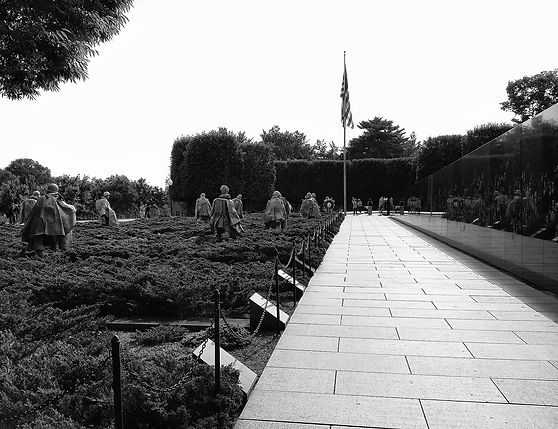Description:
Dedicated on July 27, 1995, The Korean War Veterans Memorial resides on the National Mall, southeast of the Lincoln Memorial and just south of the Reflecting Pool. This Memorial was designed and privately financed under the supervision of the Korean War Veterans Memorial Advisory Board which is run by Korean War veterans who were assigned by President Reagan. The significance of this memorial that is it honors the 5.8 million Americans who served for the United States armed services during the three-year term of the Korean War. The Korean War has been one of the most hard fought battles in American history when looking at its short duration. From June 25, 1950 to July 27, 1953, 36,574 Americans lost their lives during the Korean War. Approximately 8,200 of the 36,574 are recorded as missing in action, lost, or buried at sea. A total of 103,284 individuals were injured during the war.
General History:
Congress granted approval to the American Battle Monuments Commission, in 1986, to construct a memorial in Washington, D.C. that was in dedication to those who served in the United States armed forces during the Korean War. Ronald Reagan was assigned by the Korean War Veterans Memorial Advisory Board to suggest the location in which the monument would be built as well as establish a design for the monument and oversee the production of funds for construction. On November of 1993, the ground for where the monument would located was broken. Ronald Reagan appointed Frank Gaylord to serve as the primary sculptor of the statues and Louis Nelson to be in charge of the creation of the etched faces on the mural wall. On July 27, 1995, it marked the 42nd anniversary of the armistice that concluded the fighting of the Korean War and it was on this day that the memorial was dedicated which was led by President William J. Clinton and Kim Young Sam, President of the Republic of Korea.
The Memorial is divided into four parts: the Statues, The Mural Wall, The Pool of Remembrance, and The United Nations Wall. The Mural Wall was produced by Louis Nelson and assembled by Cold Spring Granite Company in Cold Spring, Minnesota. The Mural Wall measures 164 feet long and eight inches wide. On the surface of the wall, sandblasted pictures of 19 soldiers advancing by sea, land and air can be seen.
There are 19 stainless steel statues that were sculpted by Frank Gaylord and casted by Tallix Foundries in Beacon, New York. The 19 individuals include every branch of the United States armed forces. The Korean War Veterans Memorial is home to a United Nations wall that honors 22 members of the United Nations that took part in the war efforts. Nearby is a granite wall that quotes “Freedom Is Not Free” which gives sentiment to the constant struggle and sacrifice that American soldiers must endure in order to secure our national freedoms.
Finally, the Korean War Veterans Memorial hosts the Pool of Remembrance which has inscriptions inscribed on it with the listing of the number of soldiers that were killed, wounded, missing in action or were Prisoners-of-war during the war. The pool is approximately 30 feet in diameter.
Symbolism/Analysis:
The statues are about seven feet tall and 19 members of the party consist of 14 Army, 3 Marine, 1 Navy and 1 Air Force. The statues are position in plots of Juniper bushes and are divided by strips of granite and this is supposed to give an appearance of order and represent the rice paddies of Korea. The troops appear to be wearing ponchos to protect their supplies against the cold winds of Korea.
The Mural wall is made up of 41 panels that equal to 164 feet. Using over 2,400 photographs that were taken during the Korean War, which were acquired from the National Archives, these images were enhanced by computer in order to display a lighting effect on the uniforms of the various individual that represent the diverse branches of the United States armed forces. When observing the reflection on the granite wall with the 19 statues in the backdrop, 38 soldiers in total can be seen and this illustrates the 38th parallel, as well as the 38 month duration of the war, which was the dividing line of North and South Korea during the conflict. When looking from a distance, an image of the mountain ranges of Korea can also be seen. When looked down upon the wall from a macro view, the wall creates as an isosceles triangle, with the tip of the triangle crossing over the circle of the Pool of Remembrance.




